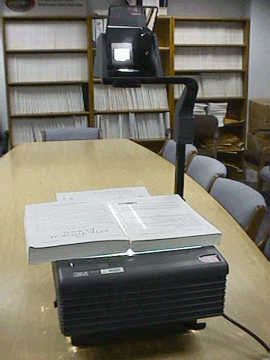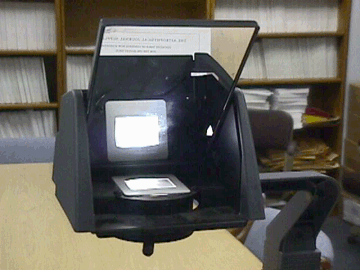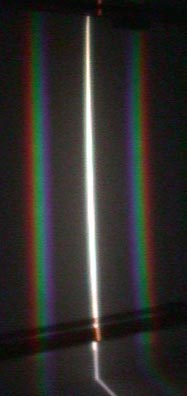Activity: Calculation Investigation
Calculation Investigation
Grade Level 11 - 12
ObjectiveIn this activity, students will learn how white light, such as that from an overhead projector, is broken up into its component colors by a diffraction grating. They will then learn the relationships between light's wavelength, frequency, and energy and how to convert between any of these characterizations of a particular color of light. Background information includes general information on the electromagnetic spectrum and the nature of light. |
Science and Math Standards
| Content Standard 1: - Mathematics as problem Solving |
Content Standard B: - Structure of Atoms - Light, heat, energy and magnetism |
| Content Standard 2: - Mathematics as Communication | |
| Content Standard 4: - Mathematical Connections |
|
| Content Standard 6: - Functions |
Pre-requisites
-
Science Students should read the background material on
the Electromagnetic Spectrum
Math Students should have a basic understanding of algebra and should have read the background material on the Electromagnetic Spectrum
IntroductionLight can be described in many ways, by its energy, its wavelength, or its frequency. All three terms are equally important, and all are interrelated. Each color in the spectrum, for example red, has a distinct energy, but also has a specific wavelength and frequency. The convention is that infrared light and visible light (the rainbow of colors our eyes can see) are usually described by wavelength, radio waves in terms of frequency, and high-energy X-rays and gamma-rays in terms of energy. This scientific convention allows the use of the units that are the most convenient for that energy of light. For example, it would be inconvenient to describe both low-energy radio waves and high-energy gamma-rays with the same units because the difference between their energies is so great. A radio wave can have an energy on the order of 4 x 10-10 eV, as opposed to 4 x 109 eV for gamma-rays. That's an energy difference of 1019, or ten million trillion, eV! |
Engagement
Using the overhead projector, prism, diffraction grating, and two sheets of cardboard, the students will set up the apparatus as illustrated below to project the spectrum of white light on a screen. Students will then pose questions about what they are observing, and what they are going to do to answer these questions.
We (and two of our teacher interns) have tried this recently. We had very good success with the overhead projector method of generating a good, large spectrum. This idea was originally published by Dr. Philip M. Sadler in the article "Projecting Spectra for Classroom Investigations," The Physics Teacher, 29(7), 1991, pp. 423-427.
You will need:
| 1) To make a visible light spectrum, plug in the projector, and turn on the lamp. Set up the projector so it is projecting at a white screen or wall. | 2) Use books on the base plate of the projector to completely block all but a single slit of light no larger than an 1" wide from being projected on the screen. Focus the projector. |
 Set-up for the experiment, including the
overhead, books to create a slit of light, and the diffraction grating
(at top of overhead)
Set-up for the experiment, including the
overhead, books to create a slit of light, and the diffraction grating
(at top of overhead)
|
 Close-up of creating the slit of light
from the overhead.
Close-up of creating the slit of light
from the overhead.
|
|
3) Place a diffraction grating over the lens at the top of the "projection
stack". Rotate the grating (if necessary) until the spectrum appears on
both sides of the projected slit on the wall or screen.
|
4) Turn off the lights, lower blinds, whatever you can do to make the room dark. You should now have a nice spectrum projected onto the screen/wall. |
 Close-up showing the placement of the
diffraction grating on the overhead lens.
Close-up showing the placement of the
diffraction grating on the overhead lens.
|
 The image on the screen shows the central
white band of light coming from the projector, plus a spectrum on both
sides.
The image on the screen shows the central
white band of light coming from the projector, plus a spectrum on both
sides. |
Exploration
Print out the Student Worksheet for the class. Have the students complete it.
Evaluation
Formative assessment and observation should be evident throughout the lesson. The worksheet, final questions during closure or a future quiz may serve as summative assessment.
Closure
If students have been keeping a lab journal, direct students to write for ten minutes in their journals summarizing the lab and all procedures in this lesson. Encourage students to then share their findings and what they might have written in their journals. Otherwise, have students create a lab report for this lesson, summarizing their findings. The format of the lab report would then be up to the teacher.
Extension
Using a supply of diffraction gratings, students can make their own spectroscope (either making "spectroscope glasses" using two gratings or a "spectroscope telescope" using one grating and a hollow tube). Students can then look at different light sources. (Caution students that they should not look a the Sun !)
Back to the Main Spectra Unit Menu

